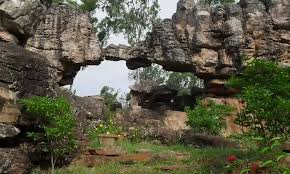Erra Matti Dibbalu

- 17 Sep 2025
In News:
Andhra Pradesh has taken a major step towards global heritage recognition with the inclusion of Erra Matti Dibbalu (Red Sand Dunes) near Visakhapatnam and the Natural Heritage of Tirumala Hills in the UNESCO Tentative List of World Heritage Sites. The move reflects India’s growing commitment to protect and preserve sites of geological and ecological importance. Being placed on the Tentative List is a mandatory prerequisite for eventual nomination to the UNESCO World Heritage List, symbolizing international acknowledgment of a site’s Outstanding Universal Value (OUV).
Erra Matti Dibbalu: India’s Rare Coastal Geo-Heritage Site
- Located along the coast near Visakhapatnam, Erra Matti Dibbalu—literally “Red Sand Dunes”—is a unique National Geo-heritage Monument, spread over 1,500 acres.
- The formations consist of sand, silt, and clay, with their deep red hue arising from natural oxidation over thousands of years.
- These dunes exhibit badland topography with striking geomorphic features such as gullies, buried channels, paired terraces, beach ridges, wave-cut terraces, knick points, and waterfalls.
- The site represents the late Quaternary geologic age and provides vital evidence of climatic and sea-level fluctuations over millennia. Dendritic drainage patterns and layered sediments at the site act as a natural archive of environmental changes and coastal evolution.
- First recorded in 1886 by British geologist William King, the site is globally rare — with only two similar formations identified, one in Sri Lanka and another in Tamil Nadu (Teri Sands).
- Additionally, archaeological artefacts discovered here point to Upper Palaeolithic human activity (around 20,000 BCE), making it an important cultural and scientific site.
- Recognizing its geological and historical significance, the Geological Survey of India (GSI) declared Erra Matti Dibbalu a National Geo-heritage Monument in 2016. However, experts warn that unregulated tourism and filming activities pose a threat to its fragile ecosystem, calling for stronger conservation and monitoring mechanisms.
- According to IUCN’s Geological World Heritage (2021) classification, the site may qualify under Theme 2: Tectonic System and Theme 7: Coastal System.
Tirumala Hills: A Geological and Ecological Treasure
- The Tirumala Hills in Tirupati district are celebrated not just for spiritual significance but also for their geological, ecological, and cultural heritage.
- The hills showcase the Eparchaean Unconformity—a rare geological boundary where 2.5-billion-year-old Archean rocks meet younger Proterozoic formations of the Cuddapah Supergroup. This boundary represents a vast time gap in Earth’s geological record, offering critical insights into planetary evolution.
- The site also houses the famous Natural Arch (Silathoranam), a naturally sculpted rock formation estimated to be 1.5 billion years old. The region forms part of the Seshachalam Biosphere Reserve and Venkateswara National Park, both home to rich biodiversity including endangered red sanders (Pterocarpus santalinus), Cycas beddomei, and the elusive Jerdon’s Courser.
- With dense forests, seasonal waterfalls, and unique geological formations, Tirumala Hills qualify under multiple UNESCO criteria related to natural beauty, ecological diversity, and geological significance. As per IUCN (2021), the site aligns with Theme 1: History of Planet Earth and Evolution of Life.
